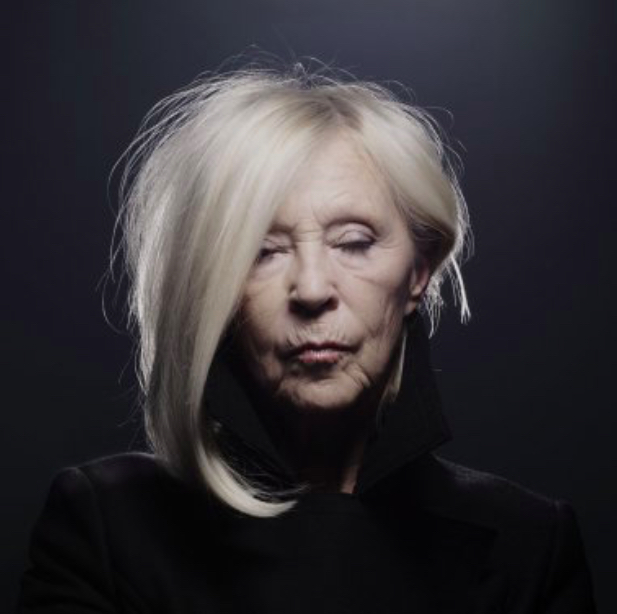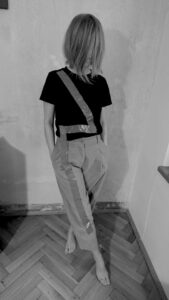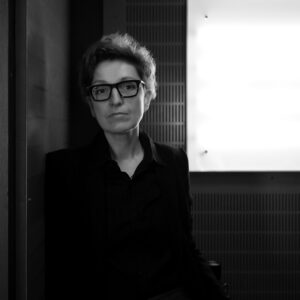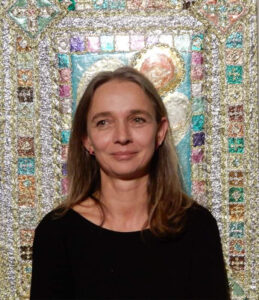Milota Havránková

– born 1945 in Košice. She arrived on the art scene in the late 1960s, at the time when experimental staged photography was beginning to assert its position more significantly within the general context of art. In 1969, she became the first female graduate in photography from the Film and TV School of the Academy of Performing Arts in Prague (FAMU). She began to discover the possibilities of stylising the photographic image, which, together with her interest in experimenting with the medium, became the key element of her entire work. After returning to Bratislava in 1972, she worked at the School of Applied Arts and influenced the strongly represented generation of photographers who later became known in Prague as the Slovak New Wave. Her further work oscillated between the poles of expression, ranging from expressive abstraction and work with a hand-manipulated positive to overlaps in the fields of design, architecture, fashion, and audio-visual image. Havránková returned to teaching in the 1990s as the Head of the Department of Photography of the Academy of Fine Arts in Bratislava, the Film and TV School of the Academy of Performing Arts in Prague and the Academy of Arts in Banská Bystrica.
My parents were highly creative – they both painted and were engaged in other creative activities. My father had a special nature – he liked experimenting and interfering in my works, and even signed them with the monogram MH – Miloslav Havránek, a.k.a. Milota Havránková. His character manifested itself not only in the creative field, but also in his regular interventions in running the household. This opened up a different view of reality, but I only understood it with the passage of time, when I began to create my own works. I was already involved in photography during my studies at the School of Applied Arts in Bratislava, but in fact I developed a deep interest in this medium while working in the Film Studios at Koliba, enchanted by the creative atmosphere. I enrolled in the Film and TV School of the Academy of Performing Arts in Prague (FAMU), in the Department of Cinematography. At that time photography was only one part of the study course. I was particularly inspired by the film image and began to stage photography to create the story. During my studies, Prague was the centre of Czech film. The currents of the Czech New Wave and Western surrealism intermingled, and thanks to the academic grounds, we were also able to see the films banned from the public view. The 1960s was the period of a generally relaxed atmosphere charged with creative enthusiasm. With the arrival of 1968, my closest friends emigrated, and the possibility of creative filmmaking in their company faded away. After considering it, I decided to continue with photography, which became a full-time study programme at the FAMU1. Even then, I perceived photography as a reflection of my personal story. At the same time, I was interested in the dynamic development of the latest technical photographic processes. I began to photograph my loved ones and tried to capture the nature of various bonds that accompany us throughout our life (photo series Transformation2, View from the Window, Family). Thus, I transcended the general perception of photography, at that time different from the common view of the medium, and therefore I often encountered misunderstanding.
For some time I worked as a freelancer, but in 1972 I started teaching in Bratislava and Prague. My methods differed from the usual curriculum and I tried to guide the students to develop their own creative expression. At the same time, school became part of my progress – it was the most dynamic period of my transformation in understanding the essence of photography.
In addition to teaching, I received various public photography commissions, which were of great importance to me in terms of technical possibilities, and paved the way to my own view of photographic representation. I tried to do everything in my work. As my approach was highly experimental, many of my major exhibitions took place abroad, where the cultural climate was much more favourable. In the domestic context, a key moment came for me in 1975, when the UNESCO declared the International Year of Women and Matica slovenská (scientific and cultural institution focusing on topics around the Slovak nation) commissioned me to create the photographic image of the Slovak woman. I decided to work on this theme through the literary work of Slovak writers and their perception of women. Despite certain reservations, a series of my photographs was exhibited at the Theatre of Martin. This experience gave me the energy to perceive my own work and myself more freely in relation to the surrounding world (photo series Revival3456, Birth78).
“Undoubtedly, age influences our activities, but the meaning and stylistic aspect of creation is part of the personality, of its specific energy.”9 “Nowadays I am involved in artistic creation when I feel the need to create and it is a completely inherent part of my life.”10 At certain moments my work naturally had an evaluative character, when I reflected on my own past and my approach to various artistic strategies (photo series MH monogram, Coming to Terms11). “Although my artistic production is created at a slower pace, it is more focused and its photographic statement is much more comprehensible. Apparently, it is due to the fact that I have gained more courage to be myself and find it easier to know the answers to my own experience.”12
The text was written in collaboration with Lujza Kotočová (2021).
1See other related interviews and the author's profile on the Memory of Nations website: https://www.pametnaroda.cz/en/havrankova-milota-1945#biography.2Image: Milota Havránková, Transformations II., 1971, photo with the permission of the author from: Antonín Dufek et al., Milota Havránková, Prague 2015, p. 11.
3Image: Milota Havránková, Self-portrait (from the series Introspection, Revival), 1979, photo with the permission of the author from: Antonín Dufek et al., Milota Havránková, Prague 2015, p. 58—59.
4Image: Milota Havránková, Self-portrait (from the series Introspection, Revival), 1979, photo with the permission of the author from: Antonín Dufek et al., Milota Havránková, Prague 2015, p. 58—59.
5Image: Milota Havránková, Self-portrait (from the series Introspection, Revival), 1979, photo with the permission of the author from: Antonín Dufek et al., Milota Havránková, Prague 2015, p. 58—59.
6Image: Milota Havránková, Self-portrait (from the series Introspection, Revival), 1979, photo with the permission of the author from: Antonín Dufek et al., Milota Havránková, Prague 2015, p. 58—59.
7Image: Milota Havránková, from the series Birth, 1980, photo with the permission of the author from: Antonín Dufek et al., Milota Havránková, Prague 2015, p. 60—61.
8Image: Milota Havránková, from the series Birth, 1980, photo with the permission of the author from: Antonín Dufek et al., Milota Havránková, Prague 2015, p. 60—61.
9See: Milota Havránková. In: Vendula Fremlová, Terezie Petišková, Anna Vartecká (eds.), Grey Gold: české a slovenské umělkyně 65 +, Brno 2014, pp. 187—192, p. 191.
10Ibidem, p. 190.
11Image: Milota Havránková, From the series Coming to terms, 1995, photo with the permission of the author from Antonín Dufek et al., Milota Havránková, Prague 2015, p. 90.
12See Fremlová, Petišková, Vartecká (eds.) (comment number 9), p. 190.
– sa narodila v roku 1945 v Košiciach. Vstúpila na umeleckú scénu koncom 60. rokov 20. storočia, v čase keď experimentálna inscenovaná fotografia si začala výraznejšie presadzovať svoju pozíciu v rámci všeobecného kontextu v umení. V roku 1969 sa stala vôbec prvou ženskou absolventkou fotografie na pražskej FAMU. Začala objavovať možnosti štylizácie fotografického obrazu, ktoré sa spoločne so záujmom o prieskum daného média stali stabilným prvkom jej celej tvorby. Po návrate do Bratislavy pôsobila od roku 1972 na Strednej škole umeleckého priemyslu a ovplyvnila silnú generáciu fotografov, ktorí sa neskôr dostali do povedomia v Prahe ako “Slovenská nová vlna”. Jej ďalšia tvorba oscilovala medzi rôznymi výrazovými pólmi siahajúcimi od expresívne ladenej abstrakcie a práce s ručne manipulovaným pozitívom až po presahy do oblasti dizajnu, architektúry, módy, či audio-vizuálu. K pedagogickej činnosti sa Havránková opätovne vrátila v 90. rokoch ako vedúca ateliérov na Vysokej škole výtvarných umení v Bratislave, ako aj na Filmovej akadémií múzických umení v Prahe a na Akadémií umení v Banskej Bystrici.
Moji rodičia boli veľmi kreatívni – obaja maľovali a venovali sa aj iným tvorivým činnostiam. Otec mal zložitú povahu, rád experimentoval a zasahoval do mojich prác, dokonca ich niekedy aj. podpisoval monogramom MH – Miloslav Havránek, akože Milota Havránková. Prejavovalo sa to nielen v kreatívnej oblasti, ale aj v jeho pravidelných zásahoch do chodu domácnosti. To nám otváralo iný pohľad na realitu, ale pochopila som to až s odstupom času, keď som sama začala tvoriť. K fotografii som sa dostala už počas štúdia na Strednej škole umeleckého priemyslu v Bratislave, ale v skutočnosti ma začala zaujímať už počas môjho pôsobenia vo Filmových ateliéroch na Kolibe, ktoré ma očarili tvorivou atmosférou. Prihlásila som sa na FAMU, na odbor kamery, kde bolo vtedy štúdium fotografie len jej súčasťou. Fascinovalo ma hlavne inscenovanie filmu a tvorba príbehu. Počas môjho štúdia bola Praha na výslní českého filmu. Prelínali sa tu prúdy Českej novej vlny a západného surrealizmu a vďaka akademickej pôde sme mohli vidieť aj filmy zakázané pre verejnosť. Šesťdesiate roky boli obdobím všeobecného uvoľnenia a tvorivého nadšenia. Potom však prišiel šesťdesiaty ôsmy rok, moji najbližší priatelia emigrovali do zahraničia a možnosť spoločného tvorivého filmovania sa rozplynula. Po zvažovaní som sa rozhodla zostať pri fotografii, ktorá sa práve na FAMU stala samostatným študijným odborom1. Už vtedy som fotografiu vnímala ako odraz reality môjho osobného príbehu. Súčasne ma oslovovala dynamika vtedajších technických fotografických postupov, ktoré boli v tejto oblasti aktuálne. Začala som fotografovať svojich blízkych a snažila som sa vystihnúť povahu rôznych väzieb, ktoré nás životom sprevádzajú (cykly Premeny2, Pohľad z okna, Rodina). Tým som prekračovala zaužívané vnímanie fotografie, ktoré bolo v tom čase odlišné od všeobecných predstáv o fotografii a preto som sa často stretávala s nepochopením.
Istý čas som pracovala v slobodnom povolaní, ale v roku 1972 som začala pôsobiť ako pedagogička v Bratislave aj v Prahe. Moje metódy sa vymykali bežným učebným osnovám a študentov som sa snažila viesť k ich vlastnému tvorivému vyjadreniu. Škola sa zároveň stala aj súčasťou môjho napredovania – bolo to najsilnejšie obdobie mojich premien v chápaní podstaty fotografickej tvorby.
Okrem pedagogickej práce som sa podieľala na rôznych konkrétnych fotografických zákazkách, ktoré mali pre mňa veľký význam z hľadiska technických možností, a otvorili mi cestu k svojskému pohľadu na fotografické zobrazenie. Vo voľnej tvorbe som si potrebovala všetko vyskúšať. Keďže môj prístup k nej bol výrazne experimentálny, mnohé z mojich zásadných výstav sa konali v zahraničí, kde bola atmosféra v oblasti kultúry oveľa uvoľnenejšia. V domácom kontexte nastal pre mňa kľúčový moment v roku 1975, keď UNESCO vyhlásilo medzinárodný Rok ženy a Matica slovenská ma oslovila, aby som prostredníctvom fotografie spracovala pohľad na slovenskú ženu. Rozhodla som sa spracovať túto tému cez tvorbu slovenských spisovateľov cez ich vnímanie ženy. Napriek výhradám bola séria mojich fotografii vystavená v martinskom divadle. Táto skúsenosť mi dodala energiu pristupovať k vlastnej tvorbe slobodnejšie a vnímať samú seba viac v súvislosti s okolitým svetom (cykly Oživenie3456, Zrod78).
„Je logické a prirodzené, že vek ovplyvňuje konanie, ale obsah a jeho formálna a štylistická stratégia sú viac ukryté v osobnosti a v jej energii.”9 „Tvorím vtedy, keď to potrebujem, je to úplne prirodzená súčasť môjho života.”10 V určitých momentoch mala moja tvorba prirodzene bilančný charakter, ktorý odrážal úsilie o reflexiu vlastnej minulosti a prístup k rôznym umeleckým stratégiám (cykly MH monogram, Vyrovnanie11). „Moja umelecká produkcia vekom je prirodzene pomalšia, zároveň je koncentrovanejšia a má podstatne čitateľnejšiu víziu a obsah. Nachádzam ľahšie odpovede na vlastné prežívanie.”12
Text bol napísaný v spolupráci s Lujzou Kotočovou (2021).
1Viď ďalšie príbuzné rozhovory a profil autorky na stránkach Paměti národa, online: https://www.pametnaroda.cz/sk/havrankova-milota-1945#biography.2Obrázok: Milota Havránková, Premeny II., 1971, foto s dovolením autorky prevzaté z: Antonín Dufek et al., Milota Havránková, Praha 2015, s. 11.
3Obrázok: Milota Havránková, Autoportrét (zo série Introspekcia, Oživenie), 1979, foto s dovolením autorky prevzaté z: Antonín Dufek et al., Milota Havránková, Praha 2015, s. 58—59.
4Obrázok: Milota Havránková, Autoportrét (zo série Introspekcia, Oživenie), 1979, foto s dovolením autorky prevzaté z: Antonín Dufek et al., Milota Havránková, Praha 2015, s. 58—59.
5Obrázok: Milota Havránková, Autoportrét (zo série Introspekcia, Oživenie), 1979, foto s dovolením autorky prevzaté z: Antonín Dufek et al., Milota Havránková, Praha 2015, s. 58—59.
6Obrázok: Milota Havránková, Autoportrét (zo série Introspekcia, Oživenie), 1979, foto s dovolením autorky prevzaté z: Antonín Dufek et al., Milota Havránková, Praha 2015, s. 58—59.
7Obrázok: Milota Havránková, Zo série Zrod, 1980, foto s dovolením autorky prevzaté z: Antonín Dufek et al., Milota Havránková, Praha 2015, s. 60—61.
8Obrázok: Milota Havránková, Zo série Zrod, 1980, foto s dovolením autorky prevzaté z: Antonín Dufek et al., Milota Havránková, Praha 2015, s. 60—61.
9Viď interview: Milota Havránková. In: Vendula Fremlová, Terezie Petišková, Anna Vartecká (eds.), Grey Gold : české a slovenské umělkyně 65 +, Brno 2014, s. 187—192, cit. s. 191.
10Ibidem, cit. s. 190.
11Obrázok: Milota Havránková, Zo série Vyrovnanie, 1995, foto s dovolením autorky prevzaté z: Antonín Dufek et al., Milota Havránková, Praha 2015, s. 90.
12Viď Fremlová, Petišková, Vartecká (eds.) (pozn. 9), s. 190.


